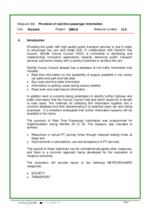Providing real-time passenger information on displays and by SMS
Thematic areas
Smart, Sustainable, Connected and Shared mobility
Summary
In a bid to increase the attractiveness of public transportation in Norwich, real-time information displays were installed at a range of locations throughout the city.
Implementing sustainable mobility
Providing the public with high-quality public transport services is an effective way of encouraging a modal shift away from the private car. Prior to measure implementation, Norfolk County Council already had a database of live traffic information, including the availability of spaces in the city’s car parks; bus routes and timetable information; information on gritting routes in severe weather conditions; and details of road closures and roadworks.
The provision of real-time passenger information from this database was intended to achieve reductions in actual public transport journey times through reduced waiting times at stops; and improvements in the image and acceptance of public transport services. The aim was to install information displays at a wide range of locations rather than only at bus stops, and to introduce sms technology to improve the accessibility of real-time information among bus users.
Progress
There were significant problems with obtaining real-time next-departure data from the existing BusNet tracking system used in Norfolk, therefore an alternative measure was implemented. This was a trial system at only one location in Norwich. Two display screens were hosted at the Norfolk and Norwich University Hospital, with feeds over the Internet of scheduled service departure information and real-time messages regarding disruptions and cancellations. Surveys were carried out before and after the trial to provide evaluation data.
In addition, service cancellations were notified by sms message to test group of 35 regular bus users and feedback was obtained after the trial.
Outcomes
The trial demonstrated that enhanced electronic information systems can improve the acceptance of public transport services. The inclusion of disruption messages alongside real-time departure information is valued by public transport users. The post-implementation surveys indicated that:
- 27 percent of respondents were aware of the display screens for bus services;
- 66 percent of respondents found the information on the displays useful;
- 47 percent of respondents said they would consider using the bus for their next journey; and
- there was a greater awareness of the frequency of bus services to and from the hospital.








